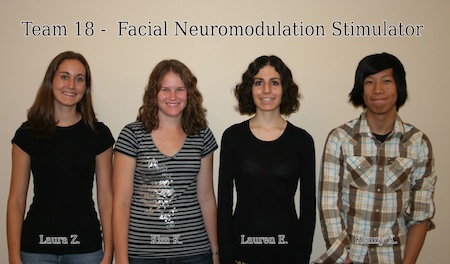Facial Neuromodulation Stimulator
Project Overview
Neuromodulation uses the mechanism of brain plasticity to modify and recruit new neural connections to compensate for loss of motor or sensory function with other areas of the brain. One way to catalyze the formation of new connections is through electrotactile stimulation. Stimulation of the tongue in this manner has shown promising rehabilitative results for patients with balance disorders; however, not all patients are able to hold a tongue stimulator in its proper position. Therefore, a face mask design that stimulates the same neural bed was requested. The final prototype of our face mask design was made of flexible silicone specifically molded to a specific subject’s face. Testing of this prototype was performed to determine the reproducibility of the threshold stimulus (the minimum stimulus required for the subject to feel stimulation) for each electrode. Results were that the prototype met our goals, having a low standard error of less than 20% of the threshold stimulus for 34 of the 36 electrodes. Future work includes using MRI to obtain a 3D image of the face in order to obtain a more accurate face mask and using liquid silicone molding, rapid prototyping, or an alginate mold to make the silicone mask.
Team Picture

Files
- Midsemester Powerpoint Presentation (October 16, 2009)
- Midsemester Report (December 5, 2009)
- Final Poster Pesentation (December 9, 2009)
- Final Report (December 9, 2009)
- Project Design Specifications (December 9, 2009)
Contact Information
Team Members
- Laura Zeitler - Team Leader
- Lauren Eichaker - Communicator
- Kimberli Kamer - BSAC
- Kenny Xu - BWIG
Advisor and Client
- Prof. Walter Block - Advisor
- Dr. Kurt Kaczmarek - Client
